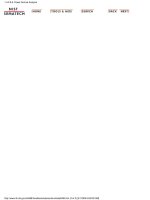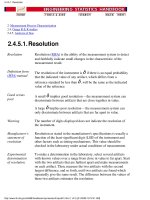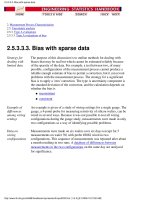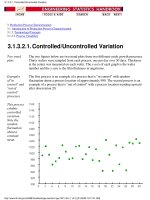Engineering Statistics Handbook Episode 4 Part 2 pot
Bạn đang xem bản rút gọn của tài liệu. Xem và tải ngay bản đầy đủ của tài liệu tại đây (85.69 KB, 16 trang )
2. Measurement Process Characterization
2.4. Gauge R & R studies
2.4.5. Analysis of bias
2.4.5.1.Resolution
Resolution Resolution (MSA) is the ability of the measurement system to detect
and faithfully indicate small changes in the characteristic of the
measurement result.
Definition from
(MSA) manual
The resolution of the instrument is
if there is an equal probability
that the indicated value of any artifact, which differs from a
reference standard by less than
, will be the same as the indicated
value of the reference.
Good versus
poor
A small
implies good resolution the measurement system can
discriminate between artifacts that are close together in value.
A large
implies poor resolution the measurement system can
only discriminate between artifacts that are far apart in value.
Warning The number of digits displayed does not indicate the resolution of
the instrument.
Manufacturer's
statement of
resolution
Resolution as stated in the manufacturer's specifications is usually a
function of the least-significant digit (LSD) of the instrument and
other factors such as timing mechanisms. This value should be
checked in the laboratory under actual conditions of measurement.
Experimental
determination
of resolution
To make a determination in the laboratory, select several artifacts
with known values over a range from close in value to far apart. Start
with the two artifacts that are farthest apart and make measurements
on each artifact. Then, measure the two artifacts with the second
largest difference, and so forth, until two artifacts are found which
repeatedly give the same result. The difference between the values of
these two artifacts estimates the resolution.
2.4.5.1. Resolution
(1 of 2) [5/1/2006 10:12:41 AM]
Consequence of
poor resolution
No useful information can be gained from a study on a gauge with
poor resolution relative to measurement needs.
2.4.5.1. Resolution
(2 of 2) [5/1/2006 10:12:41 AM]
Test for
linearity
Tests for the slope and bias are described in the section on instrument
calibration. If the slope is different from one, the gauge is non-linear
and requires calibration or repair. If the intercept is different from zero,
the gauge has a bias.
Causes of
non-linearity
The reference manual on Measurement Systems Analysis (MSA) lists
possible causes of gauge non-linearity that should be investigated if the
gauge shows symptoms of non-linearity.
Gauge not properly calibrated at the lower and upper ends of the
operating range
1.
Error in the value of
X at the maximum or minimum range2.
Worn gauge3.
Internal design problems (electronics)4.
Note - on
artifact
calibration
The requirement of linearity for artifact calibration is not so stringent.
Where the gauge is used as a comparator for measuring small
differences among test items and reference standards of the same
nominal size, as with calibration designs, the only requirement is that
the gauge be linear over the small on-scale range needed to measure
both the reference standard and the test item.
Situation
where the
calibration of
the gauge is
neglected
Sometimes it is not economically feasible to correct for the calibration
of the gauge ( Turgel and Vecchia). In this case, the bias that is
incurred by neglecting the calibration is estimated as a component of
uncertainty.
2.4.5.2. Linearity of the gauge
(2 of 2) [5/1/2006 10:12:42 AM]
2. Measurement Process Characterization
2.4. Gauge R & R studies
2.4.5. Analysis of bias
2.4.5.4.Differences among gauges
Purpose A gauge study should address whether gauges agree with one another and whether
the agreement (or disagreement) is consistent over artifacts and time.
Data
collection
For each gauge in the study, the analysis requires measurements on
Q (Q > 2) check standards
●
K (K > 2) days●
The measurements should be made by a single operator.
Data
reduction
The steps in the analysis are:
Measurements are averaged over days by artifact/gauge configuration.1.
For each artifact, an average is computed over gauges.2.
Differences from this average are then computed for each gauge.3.
If the design is run as a 3-level design, the statistics are computed separately
for each run.
4.
Data from a
gauge study
The data in the table below come from resistivity (ohm.cm) measurements on Q = 5
artifacts on K = 6 days. Two runs were made which were separated by about a
month's time. The artifacts are silicon wafers and the gauges are four-point probes
specifically designed for measuring resistivity of silicon wafers. Differences from the
wafer means are shown in the table.
Biases for 5
probes from a
gauge study
with 5
artifacts on 6
days
Table of biases for probes and silicon wafers (ohm.cm)
Wafers
Probe 138 139 140 141 142
1 0.02476 -0.00356 0.04002 0.03938 0.00620
181 0.01076 0.03944 0.01871 -0.01072 0.03761
182 0.01926 0.00574 -0.02008 0.02458 -0.00439
2.4.5.4. Differences among gauges
(1 of 2) [5/1/2006 10:12:42 AM]
2062 -0.01754 -0.03226 -0.01258 -0.02802 -0.00110
2362 -0.03725 -0.00936 -0.02608 -0.02522 -0.03830
Plot of
differences
among
probes
A graphical analysis can be more effective for detecting differences among gauges
than a table of differences. The differences are plotted versus artifact identification
with each gauge identified by a separate plotting symbol. For ease of interpretation,
the symbols for any one gauge can be connected by dotted lines.
Interpretation Because the plots show differences from the average by artifact, the center line is the
zero-line, and the differences are estimates of bias. Gauges that are consistently
above or below the other gauges are biased high or low, respectively, relative to the
average. The best estimate of bias for a particular gauge is its average bias over the Q
artifacts. For this data set, notice that probe #2362 is consistently biased low relative
to the other probes.
Strategies for
dealing with
differences
among
gauges
Given that the gauges are a random sample of like-kind gauges, the best estimate in
any situation is an average over all gauges. In the usual production or metrology
setting, however, it may only be feasible to make the measurements on a particular
piece with one gauge. Then, there are two methods of dealing with the differences
among gauges.
Correct each measurement made with a particular gauge for the bias of that
gauge and report the standard deviation of the correction as a type A
uncertainty.
1.
Report each measurement as it occurs and assess a type A uncertainty for the
differences among the gauges.
2.
2.4.5.4. Differences among gauges
(2 of 2) [5/1/2006 10:12:42 AM]
39. 6 2062. -0.0034 -0.0018
63. 1 2062. -0.0016 0.0092
63. 2 2062. -0.0111 0.0040
63. 3 2062. -0.0059 0.0067
63. 4 2062. -0.0078 0.0016
63. 5 2062. -0.0007 0.0020
63. 6 2062. 0.0006 0.0017
103. 1 2062. -0.0050 0.0076
103. 2 2062. -0.0140 0.0002
103. 3 2062. -0.0048 0.0025
103. 4 2062. 0.0018 0.0045
103. 5 2062. 0.0016 -0.0025
103. 6 2062. 0.0044 0.0035
125. 1 2062. -0.0056 0.0099
125. 2 2062. -0.0155 0.0123
125. 3 2062. -0.0010 0.0042
125. 4 2062. -0.0014 0.0098
125. 5 2062. 0.0003 0.0032
125. 6 2062. -0.0017 0.0115
Test of
difference
between
configurations
Because there are only two configurations, a t-test is used to decide if there is a
difference. If
the difference between the two configurations is statistically significant.
The average and standard deviation computed from the 29 differences in each run are
shown in the table below along with the t-values which confirm that the differences are
significant for both runs.
Average differences between wiring
configurations
Run Probe Average Std dev N
t
2.4.5.5. Geometry/configuration differences
(2 of 3) [5/1/2006 10:12:43 AM]
1 2062 - 0.00383 0.00514 29
-4.0
2 2062 + 0.00489 0.00400 29
+6.6
Unexpected
result
The data reveal a wiring bias for both runs that changes direction between runs. This is a
somewhat disturbing finding, and further study of the gauges is needed. Because neither
wiring configuration is preferred or known to give the 'correct' result, the differences are
treated as a component of the measurement uncertainty.
2.4.5.5. Geometry/configuration differences
(3 of 3) [5/1/2006 10:12:43 AM]
Differences
among gauges
or
configurations
Significant differences among gauges/configurations can be treated in
one of two ways:
By correcting each measurement for the bias of the specific
gauge/configuration.
1.
By accepting the difference as part of the uncertainty of the
measurement process.
2.
Differences
among
operators
Differences among operators can be viewed in the same way as
differences among gauges. However, an operator who is incapable of
making measurements to the required precision because of an
untreatable condition, such as a vision problem, should be re-assigned
to other tasks.
2.4.5.6. Remedial actions and strategies
(2 of 2) [5/1/2006 10:12:43 AM]
General
guidance
The following sections outline the general approach to uncertainty
analysis and give methods for combining the standard deviations into a
final uncertainty:
Approach1.
Methods for type A evaluations2.
Methods for type B evaluations3.
Propagation of error4.
Error budgets and sensitivity coefficients5.
Standard and expanded uncertainties6.
Treatment of uncorrected biases7.
Type A
evaluations
of random
error
Data collection methods and analyses of random sources of uncertainty
are given for the following:
Repeatability of the gauge1.
Reproducibility of the measurement process2.
Stability (very long-term) of the measurement process3.
Biases - Rule
of thumb
The approach for biases is to estimate the maximum bias from a gauge
study and compute a standard uncertainty from the maximum bias
assuming a suitable distribution. The formulas shown below assume a
uniform distribution for each bias.
Determining
resolution
If the resolution of the gauge is
, the standard uncertainty for
resolution is
Determining
non-linearity
If the maximum departure from linearity for the gauge has been
determined from a gauge study, and it is reasonable to assume that the
gauge is equally likely to be engaged at any point within the range
tested, the standard uncertainty for linearity is
2.4.6. Quantifying uncertainties from a gauge study
(2 of 3) [5/1/2006 10:12:44 AM]
Hysteresis Hysteresis, as a performance specification, is defined (NCSL RP-12) as
the maximum difference between the upscale and downscale readings
on the same artifact during a full range traverse in each direction. The
standard uncertainty for hysteresis is
Determining
drift
Drift in direct reading instruments is defined for a specific time interval
of interest. The standard uncertainty for drift is
where Y
0
and Y
t
are measurements at time zero and t, respectively.
Other biases Other sources of bias are discussed as follows:
Differences among gauges1.
Differences among configurations2.
Case study:
Type A
uncertainties
from a
gauge study
A case study on type A uncertainty analysis from a gauge study is
recommended as a guide for bringing together the principles and
elements discussed in this section. The study in question characterizes
the uncertainty of resistivity measurements made on silicon wafers.
2.4.6. Quantifying uncertainties from a gauge study
(3 of 3) [5/1/2006 10:12:44 AM]
standard
Sensitivity coefficients for measurements with a 2-level
design
3.
Sensitivity coefficients for measurements with a 3-level
design
4.
Example of error budget5.
Standard and expanded uncertainties
Degrees of freedom1.
7.
Treatment of uncorrected bias
Computation of revised uncertainty1.
8.
2.5. Uncertainty analysis
(2 of 2) [5/1/2006 10:12:45 AM]
Relationship to
interlaboratory
test results
Many laboratories or industries participate in interlaboratory studies
where the test method itself is evaluated for:
repeatability within laboratories
●
reproducibility across laboratories●
These evaluations do not lead to uncertainty statements because the
purpose of the interlaboratory test is to evaluate, and then improve,
the test method as it is applied across the industry. The purpose of
uncertainty analysis is to evaluate the result of a particular
measurement, in a particular laboratory, at a particular time.
However, the two purposes are related.
Default
recommendation
for test
laboratories
If a test laboratory has been party to an interlaboratory test that
follows the recommendations and analyses of an American Society
for Testing Materials standard (ASTM E691) or an ISO standard
(ISO 5725), the laboratory can, as a default, represent its standard
uncertainty for a single measurement as the reproducibility standard
deviation as defined in ASTM E691 and ISO 5725. This standard
deviation includes components for within-laboratory repeatability
common to all laboratories and between-laboratory variation.
Drawbacks of
this procedure
The standard deviation computed in this manner describes a future
single measurement made at a laboratory randomly drawn from the
group and leads to a prediction interval (Hahn & Meeker) rather
than a confidence interval. It is not an ideal solution and may
produce either an unrealistically small or unacceptably large
uncertainty for a particular laboratory. The procedure can reward
laboratories with poor performance or those that do not follow the
test procedures to the letter and punish laboratories with good
performance. Further, the procedure does not take into account
sources of uncertainty other than those captured in the
interlaboratory test. Because the interlaboratory test is a snapshot at
one point in time, characteristics of the measurement process over
time cannot be accurately evaluated. Therefore, it is a strategy to be
used only where there is no possibility of conducting a realistic
uncertainty investigation.
2.5.1. Issues
(2 of 2) [5/1/2006 10:12:45 AM]
ISO
definition of
uncertainty
Uncertainty, as defined in the ISO Guide to the Expression of
Uncertainty in Measurement (GUM) and the International Vocabulary
of Basic and General Terms in Metrology (VIM), is a
"parameter, associated with the result of a measurement,
that characterizes the dispersion of the values that could
reasonably be attributed to the measurand."
Consistent
with
historical
view of
uncertainty
This definition is consistent with the well-established concept that an
uncertainty statement assigns credible limits to the accuracy of a
reported value, stating to what extent that value may differ from its
reference value (Eisenhart). In some cases, reference values will be
traceable to a national standard, and in certain other cases, reference
values will be consensus values based on measurements made
according to a specific protocol by a group of laboratories.
Accounts for
both random
error and
bias
The estimation of a possible discrepancy takes into account both
random error and bias in the measurement process. The distinction to
keep in mind with regard to random error and bias is that random
errors cannot be corrected, and biases can, theoretically at least, be
corrected or eliminated from the measurement result.
Relationship
to precision
and bias
statements
Precision and bias are properties of a measurement method.
Uncertainty is a property of a specific result for a single test item that
depends on a specific measurement configuration
(laboratory/instrument/operator, etc.). It depends on the repeatability of
the instrument; the reproducibility of the result over time; the number
of measurements in the test result; and all sources of random and
systematic error that could contribute to disagreement between the
result and its reference value.
Handbook
follows the
ISO
approach
This Handbook follows the ISO approach (GUM) to stating and
combining components of uncertainty. To this basic structure, it adds a
statistical framework for estimating individual components,
particularly those that are classified as type A uncertainties.
2.5.2. Approach
(2 of 4) [5/1/2006 10:12:45 AM]
Basic ISO
tenets
The ISO approach is based on the following rules:
Each uncertainty component is quantified by a standard
deviation.
●
All biases are assumed to be corrected and any uncertainty is the
uncertainty of the correction.
●
Zero corrections are allowed if the bias cannot be corrected and
an uncertainty is assessed.
●
All uncertainty intervals are symmetric.●
ISO
approach to
classifying
sources of
error
Components are grouped into two major categories, depending on the
source of the data and not on the type of error, and each component is
quantified by a standard deviation. The categories are:
Type A - components evaluated by statistical methods
●
Type B - components evaluated by other means (or in other
laboratories)
●
Interpretation
of this
classification
One way of interpreting this classification is that it distinguishes
between information that comes from sources local to the measurement
process and information from other sources although this
interpretation does not always hold. In the computation of the final
uncertainty it makes no difference how the components are classified
because the ISO guidelines treat type A and type B evaluations in the
same manner.
Rule of
quadrature
All uncertainty components (standard deviations) are combined by
root-sum-squares (quadrature) to arrive at a 'standard uncertainty', u,
which is the standard deviation of the reported value, taking into
account all sources of error, both random and systematic, that affect the
measurement result.
Expanded
uncertainty
for a high
degree of
confidence
If the purpose of the uncertainty statement is to provide coverage with
a high level of confidence, an expanded uncertainty is computed as
U = k u
where k is chosen to be the critical value from the t-table for
v degrees of freedom.
For large degrees of freedom, it is suggested to use
k = 2 to
approximate 95% coverage. Details for these calculations are found
under degrees of freedom.
2.5.2. Approach
(3 of 4) [5/1/2006 10:12:45 AM]
Type B
evaluations
Type B evaluations apply to random errors and biases for which there
is little or no data from the local process, and to random errors and
biases from other measurement processes.
2.5.2. Approach
(4 of 4) [5/1/2006 10:12:45 AM]
Compute a standard deviation for each type B component of
uncertainty.
3.
Combine type A and type B standard deviations into a standard
uncertainty for the reported result using sensitivity factors.
4.
Compute an expanded uncertainty.5.
Outline of
steps to be
followed in
the
evaluation
of
uncertainty
involving
several
secondary
quantities
B. - Reported value involves more than one quantity.
Write down the equation showing the relationship between the
quantities.
Write-out the propagation of error equation and do a
preliminary evaluation, if possible, based on propagation of
error.
❍
1.
If the measurement result can be replicated directly, regardless
of the number of secondary quantities in the individual
repetitions, treat the uncertainty evaluation as in (A.1) to (A.5)
above, being sure to evaluate all sources of random error in the
process.
2.
If the measurement result cannot be replicated directly, treat
each measurement quantity as in (A.1) and (A.2) and:
Compute a standard deviation for each measurement
quantity.
❍
Combine the standard deviations for the individual
quantities into a standard deviation for the reported result
via propagation of error.
❍
3.
Compute a standard deviation for each type B component of
uncertainty.
4.
Combine type A and type B standard deviations into a standard
uncertainty for the reported result.
5.
Compute an expanded uncertainty.6.
Compare the uncerainty derived by propagation of error with the
uncertainty derived by data analysis techniques.
7.
2.5.2.1. Steps
(2 of 2) [5/1/2006 10:12:45 AM]









